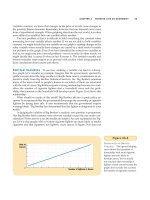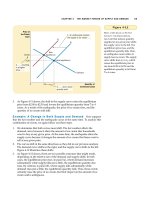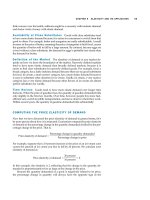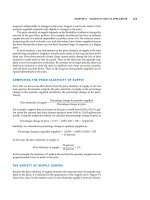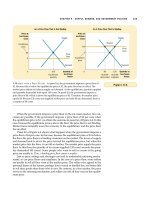Tài liệu Ten Principles of Economics - Part 66 ppt
Bạn đang xem bản rút gọn của tài liệu. Xem và tải ngay bản đầy đủ của tài liệu tại đây (247.16 KB, 10 trang )
CHAPTER 29 OPEN-ECONOMY MACROECONOMICS: BASIC CONCEPTS 673
CASE STUDY
THE NOMINAL EXCHANGE RATE
DURING A HYPERINFLATION
Macroeconomists can only rarely conduct controlled experiments. Most often,
they must glean what they can from the natural experiments that history gives
them. One natural experiment is hyperinflation—the high inflation that arises
when a government turns to the printing press to pay for large amounts of gov-
ernment spending. Because hyperinflations are so extreme, they illustrate some
basic economic principles with clarity.
Consider the German hyperinflation of the early 1920s. Figure 29-3 shows
the German money supply, the German price level, and the nominal exchange
rate (measured as U.S. cents per German mark) for that period. Notice that
these series move closely together. When the supply of money starts growing
quickly, the price level also takes off, and the German mark depreciates. When
the money supply stabilizes, so does the price level and the exchange rate.
The pattern shown in this figure appears during every hyperinflation. It
leaves no doubt that there is a fundamental link among money, prices, and the
nominal exchange rate. The quantity theory of money discussed in the previous
chapter explains how the money supply affects the price level. The theory of
purchasing-power parity discussed here explains how the price level affects the
nominal exchange rate.
That is, the nominal exchange rate equals the ratio of the foreign price level (mea-
sured in units of the foreign currency) to the domestic price level (measured in
units of the domestic currency). According to the theory of purchasing-power parity, the
nominal exchange rate between the currencies of two countries must reflect the different
price levels in those countries.
A key implication of this theory is that nominal exchange rates change when
price levels change. As we saw in the preceding chapter, the price level in any
country adjusts to bring the quantity of money supplied and the quantity of
money demanded into balance. Because the nominal exchange rate depends on
the price levels, it also depends on the money supply and money demand in each
country. When a central bank in any country increases the money supply and
causes the price level to rise, it also causes that country’s currency to depreciate
relative to other currencies in the world. In other words, when the central bank prints
large quantities of money, that money loses value both in terms of the goods and services it
can buy and in terms of the amount of other currencies it can buy.
We can now answer the question that began this section: Why has the U.S. dol-
lar lost value compared to the German mark and gained value compared to the
Italian lira? The answer is that Germany has pursued a less inflationary monetary
policy than the United States, and Italy has pursued a more inflationary monetary
policy. From 1970 to 1998, inflation in the United States was 5.3 percent per year.
By contrast, inflation was 3.5 percent in Germany, and 9.6 percent in Italy. As U.S.
prices rose relative to German prices, the value of the dollar fell relative to the
mark. Similarly, as U.S. prices fell relative to Italian prices, the value of the dollar
rose relative to the lira.
674 PART ELEVEN THE MACROECONOMICS OF OPEN ECONOMIES
LIMITATIONS OF PURCHASING-POWER PARITY
Purchasing-power parity provides a simple model of how exchange rates are de-
termined. For understanding many economic phenomena, the theory works well.
In particular, it can explain many long-term trends, such as the depreciation of the
U.S. dollar against the German mark and the appreciation of the U.S. dollar
against the Italian lira. It can also explain the major changes in exchange rates that
occur during hyperinflations.
Yet the theory of purchasing-power parity is not completely accurate. That is,
exchange rates do not always move to ensure that a dollar has the same real value
in all countries all the time. There are two reasons why the theory of purchasing-
power parity does not always hold in practice.
The first reason is that many goods are not easily traded. Imagine, for instance,
that haircuts are more expensive in Paris than in New York. International travelers
might avoid getting their haircuts in Paris, and some haircutters might move from
New York to Paris. Yet such arbitrage would probably be too limited to eliminate
the differences in prices. Thus, the deviation from purchasing-power parity might
persist, and a dollar (or franc) would continue to buy less of a haircut in Paris than
in New York.
The second reason that purchasing-power parity does not always hold is that
even tradable goods are not always perfect substitutes when they are produced in
different countries. For example, some consumers prefer German beer, and others
prefer American beer. Moreover, consumer tastes for beer change over time. If Ger-
man beer suddenly becomes more popular, the increase in demand will drive up
10,000,000,000
1,000,000,000,000,000
100,000
1
.00001
.0000000001
1921 1922 1923 1924
Exchange rate
Money supply
Price level
1925
Indexes
(Jan. 1921
ϭ
100)
Figure 29-3
M
ONEY
, P
RICES
,
AND THE
N
OMINAL
E
XCHANGE
R
ATE
DURING THE
G
ERMAN
H
YPERINFLATION
. This figure
shows the money supply, the
price level, and the exchange rate
(measured as U.S. cents per
mark) for the German
hyperinflation from January 1921
to December 1924. Notice how
similarly these three variables
move. When the quantity of
money started growing quickly,
the price level followed, and the
mark depreciated relative to the
dollar. When the German central
bank stabilized the money
supply, the price level and
exchange rate stabilized as well.
S
OURCE
: Adapted from Thomas J. Sargent,
“The End of Four Big Inflations,” in Robert
Hall, ed., Inflation (Chicago: University of
Chicago Press, 1983), pp. 41–93.
CHAPTER 29 OPEN-ECONOMY MACROECONOMICS: BASIC CONCEPTS 675
CASE STUDY
THE HAMBURGER STANDARD
When economists apply the theory of purchasing-power parity to explain ex-
change rates, they need data on the prices of a basket of goods available in dif-
ferent countries. One analysis of this sort is conducted by The Economist, an
international newsmagazine. The magazine occasionally collects data on a bas-
ket of goods consisting of “two all beef patties, special sauce, lettuce, cheese,
pickles, onions, on a sesame seed bun.” It’s called the “Big Mac” and is sold by
McDonald’s around the world.
Once we have the prices of Big Macs in two countries denominated in the
local currencies, we can compute the exchange rate predicted by the theory of
purchasing-power parity. The predicted exchange rate is the one that makes the
cost of the Big Mac the same in the two countries. For instance, if the price of a
Big Mac is $2 in the United States and 200 yen in Japan, purchasing-power par-
ity would predict an exchange rate of 100 yen per dollar.
How well does purchasing-power parity work when applied using Big Mac
prices? Here are some examples from an Economist article published on April 3,
1999, when the price of a Big Mac was $2.43 in the United States:
P
RICE OF
P
REDICTED
A
CTUAL
C
OUNTRY A
B
IG
M
AC
E
XCHANGE
R
AT E
E
XCHANGE
R
AT E
Italy 4,500 lira 1,852 lira/$ 1,799 lira/$
Japan 294 yen 121 yen/$ 120 yen/$
Russia 33.5 rubles 13.8 rubles/$ 24.7 rubles/$
Germany 4.95 marks 2.04 marks/$ 1.82 marks/$
Brazil 2.95 reals 1.21 reals/$ 1.73 reals/$
Britain 1.90 pounds 0.78 pound/$ 0.62 pound/$
You can see that the predicted and actual exchange rates are not exactly the
same. After all, international arbitrage in Big Macs is not easy. Yet the two
exchange rates are usually in the same ballpark. Purchasing-power parity is not
the price of German beer. As a result, a dollar (or a mark) might then buy more
beer in the United States than in Germany. But despite this difference in prices in
the two markets, there might be no opportunity for profitable arbitrage because
consumers do not view the two beers as equivalent.
Thus, both because some goods are not tradable and because some tradable
goods are not perfect substitutes with their foreign counterparts, purchasing-
power parity is not a perfect theory of exchange-rate determination. For these rea-
sons, real exchange rates fluctuate over time. Nonetheless, the theory of
purchasing-power parity does provide a useful first step in understanding ex-
change rates. The basic logic is persuasive: As the real exchange rate drifts from the
level predicted by purchasing-power parity, people have greater incentive to move
goods across national borders. Even if the forces of purchasing-power parity do
not completely fix the real exchange rate, they provide a reason to expect that
changes in the real exchange rate are most often small or temporary. As a result,
large and persistent movements in nominal exchange rates typically reflect
changes in price levels at home and abroad.
I
NTHE
U
NITED
S
TATESTHE PRICE OF
A
B
IG
M
AC IS
$2.43;
IN
J
APAN IT IS
294
YEN
.
676 PART ELEVEN THE MACROECONOMICS OF OPEN ECONOMIES
a precise theory of exchange rates, but it often provides a reasonable first
approximation.
QUICK QUIZ: Over the past 20 years, Spain has had high inflation, and
Japan has had low inflation. What do you predict has happened to the number
of Spanish pesetas a person can buy with a Japanese yen?
CONCLUSION
The purpose of this chapter has been to develop some basic concepts that macro-
economists use to study open economies. You should now understand why a na-
tion’s net exports must equal its net foreign investment, and why national saving
must equal domestic investment plus net foreign investment. You should also un-
derstand the meaning of the nominal and real exchange rates, as well as the impli-
cations and limitations of purchasing-power parity as a theory of how exchange
rates are determined.
The macroeconomic variables defined here offer a starting point for analyzing
an open economy’s interactions with the rest of the world. In the next chapter we
develop a model that can explain what determines these variables. We can then
discuss how various events and policies affect a country’s trade balance and the
rate at which nations make exchanges in world markets.
◆ Net exports are the value of domestic goods and
services sold abroad minus the value of foreign goods
and services sold domestically. Net foreign investment
is the acquisition of foreign assets by domestic residents
minus the acquisition of domestic assets by foreigners.
Because every international transaction involves an
exchange of an asset for a good or service, an economy’s
net foreign investment always equals its net exports.
◆ An economy’s saving can be used either to finance
investment at home or to buy assets abroad. Thus,
national saving equals domestic investment plus net
foreign investment.
◆ The nominal exchange rate is the relative price of the
currency of two countries, and the real exchange rate
is the relative price of the goods and services of two
countries. When the nominal exchange rate changes so
that each dollar buys more foreign currency, the dollar is
said to appreciate or strengthen. When the nominal
exchange rate changes so that each dollar buys less
foreign currency, the dollar is said to depreciate or weaken.
◆ According to the theory of purchasing-power parity, a
dollar (or a unit of any other currency) should be able to
buy the same quantity of goods in all countries. This
theory implies that the nominal exchange rate between
the currencies of two countries should reflect the price
levels in those countries. As a result, countries with
relatively high inflation should have depreciating
currencies, and countries with relatively low inflation
should have appreciating currencies.
Summary
CHAPTER 29 OPEN-ECONOMY MACROECONOMICS: BASIC CONCEPTS 677
closed economy, p. 658
open economy, p. 658
exports, p. 658
imports, p. 658
net exports, p. 658
trade balance, p. 658
trade surplus, p. 658
trade deficit, p. 659
balanced trade, p. 659
net foreign investment, p. 661
nominal exchange rate, p. 668
appreciation, p. 668
depreciation, p. 668
real exchange rate, p. 669
purchasing-power parity, p. 670
Key Concepts
1. Define net exports and net foreign investment. Explain
how and why they are related.
2. Explain the relationship among saving, investment, and
net foreign investment.
3. If a Japanese car costs 500,000 yen, a similar American
car costs $10,000, and a dollar can buy 100 yen, what are
the nominal and real exchange rates?
4. Describe the economic logic behind the theory of
purchasing-power parity.
5. If the Fed started printing large quantities of U.S.
dollars, what would happen to the number of Japanese
yen a dollar could buy?
Questions for Review
1. How would the following transactions affect U.S.
exports, imports, and net exports?
a. An American art professor spends the summer
touring museums in Europe.
b. Students in Paris flock to see the latest Arnold
Schwarzenegger movie.
c. Your uncle buys a new Volvo.
d. The student bookstore at Oxford University sells a
pair of Levi’s 501 jeans.
e. A Canadian citizen shops at a store in northern
Vermont to avoid Canadian sales taxes.
2. International trade in each of the following products has
increased over time. Suggest some reasons why this
might be so.
a. wheat
b. banking services
c. computer software
d. automobiles
3. Describe the difference between foreign direct
investment and foreign portfolio investment. Who is
more likely to engage in foreign direct investment—a
corporation or an individual investor? Who is more
likely to engage in foreign portfolio investment?
4. How would the following transactions affect U.S. net
foreign investment? Also, state whether each involves
direct investment or portfolio investment.
a. An American cellular phone company establishes
an office in the Czech Republic.
b. Harrod’s of London sells stock to the General
Electric pension fund.
c. Honda expands its factory in Marysville, Ohio.
d. A Fidelity mutual fund sells its Volkswagen stock to
a French investor.
5. Holding national saving constant, does an increase in
net foreign investment increase, decrease, or have no
effect on a country’s accumulation of domestic capital?
6. The business section of most major newspapers contains
a table showing U.S. exchange rates. Find such a table
and use it to answer the following questions.
a. Does this table show nominal or real exchange
rates? Explain.
b. What are the exchange rates between the United
States and Canada and between the United States
and Japan? Calculate the exchange rate between
Canada and Japan.
c. If U.S. inflation exceeds Japanese inflation over
the next year, would you expect the U.S. dollar
to appreciate or depreciate relative to the
Japanese yen?
7. Would each of the following groups be happy or
unhappy if the U.S. dollar appreciated? Explain.
Problems and Applications
